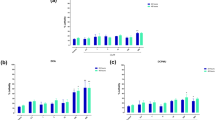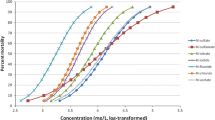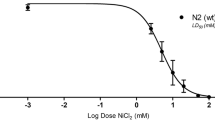Abstract
Lethality changes were investigated during development in 4 h metal exposed Caenorhabditis elegans. Exposure to examined metals caused severe lethality toxicities in L1- and L2-larvae, in L3-larvae exposed to examined metals at concentrations of 50 and 100 μM and to Pb, Hg, and Cr at the concentration of 2.5 μM, in L4-larvae exposed to examined metals at concentrations of 50 and 100 μM, and in adults exposed to Pb, Hg, and Cr at the concentration of 100 μM. Moreover, the lethality toxicities induced by Pb and Hg in L1 larvae for 4 h could be largely comparable to those in young adults for 24 h.






Similar content being viewed by others
References
America Society for Testing and Materials (ASTM) (2002) Standard guide for conducting laboratory soil toxicity tests with the nematode C. elegans. E 2172-01. In: Annual book of ASTM standard, vol 11.05. ASTM, West Conshohocken, PA, pp 1606–1616
Anderson GL, Boyd WA, Williams PL (2001) Assessment of sublethal endpoints for toxicity testing with the nematode C. elegans. Environ Toxicol Chem 20:833–838
Barsyte D, Lovejoy DA, Lithgow GJ (2001) Longevity and heavy metal resistance in daf-2 and age-1 long-lived mutants of C. elegans. FASEB J 15:627–634
Boyd WA, Williams PL (2003) Availability of metals to the nematode C. elegans toxicity based on total concentrations in soil and extracted fractions. Environ Toxicol Chem 22:1100–1106
Brenner S (1974) The genetics of C. elegans. Genetics 77:71–94
Chu KW, Chow KL (2002) Synergistic toxicity of multiple heavy metals is revealed by a biological assay using a nematode and its transgenic derivative. Aquat Toxicol 61:53–64. doi:10.1016/S0166-445X(02)00017-6
Chu KW, Chan SKW, Chow KL (2005) Improvement of heavy metal stress and toxicity assays by coupling a transgenic reporter in a mutant nematode strain. Aquat Toxicol 74:320–332. doi:10.1016/j.aquatox.2005.06.006
Dengg M, van Meel JCA (2004) C. elegans as model system for rapid toxicity assessment of pharmaceutical compounds. J Pharmacol Toxicol Methods 50:209–214. doi:10.1016/j.vascn.2004.04.002
Donkin SG, Dusenbery DB (1993) A soil toxicity test using the nematode C. elegans and an effective method of recovery. Arch Environ Contam Toxicol 25:145–151
Donkin SG, Williams PL (1995) Influence of developmental stage, salts and food presence on various end points using C. elegans for aquatic toxicity testing. Environ Toxicol Chem 14:2139–2147
Graves AL, Boyd WA, Williams PL (2005) Using transgenic C. elegans in soil toxicity testing. Arch Environ Contam Toxicol 48:490–494. doi:10.1007/s00244-004-0031-2
Hitchcock DR, Black MC, Williams PL (1997) Investigations into using the nematode C. elegans for municipal and industrial wastewater toxicity testing. Arch Environ Contam Toxicol 33:252–260
Hughes S, Stürzenbaum SR (2007) Single and double metallothionein knockout in the nematode C. elegans reveals cadmium dependent and independent toxic effects on life history traits. Environ Pollut 145:395–400. doi:10.1016/j.envpol.2006.06.003
Jones D, Candido EPM (1999) Feeding is inhibited by sublethal concentrations of toxicants and by heat stress in the nematode C. elegans relationship to the cellular stress response. J Exp Zool 284:147–157
Morser VC (1999) Comparison of aldicarb and methamidophos neurotoxicity at different ages in the rat behavioral and biochemical parameters. Toxicol Appl Pharmacol 157:94–106. doi:10.1006/taap.1999.8675
Morser VC (2000) Dose-response and time-course of neurobehavioral changes following oral chlorpyrifos in rats of different ages. Neurotoxicol Teratol 22:713–723. doi:10.1016/S0892-0362(00)00087-8
Mutwakil MHAZ, Reader JP, Holdich DM, Smithurst PR, Candido EPM, Jones D, Stringham EG, de Pomerai DI (1997) Use of stress-inducible transgenic nematodes as biomarkers of heavy metal pollution in water samples from an english river system. Arch Environ Contam Toxicol 32:146–153
Peredney CL, Williams PL (2000) Utility of C. elegans for assessing heavy metal contamination in artificial soil. Arch Environ Contam Toxicol 39:113–118. doi:10.1007/s002440010086
Riddle DL, Blumenthal T, Meyer BJ, Priess JR (1997) C. ELEGANS II. Cold Spring Harbor Laboratory Press, Plainview, New York
Roh J, Jung I, Lee J, Choi J (2007) Toxic effects of di(2-ethylhexyl)phthalate on mortality, growth, reproduction and stress-related gene expression in the soil nematode C. elegans. Toxicology 237:126–133. doi:10.1016/j.tox.2007.05.008
Shen L-L, Xiao J, Ye H-Y, Wang D-Y (2009) Toxicity evaluation in nematode C. elegans after chronic metal exposure. Environ Toxicol Pharmacol 28:125–132. doi:10.1016/j.etap.2009.03.009
Sochová I, Hofman J, Holoubek I (2007) Effects of seven organic pollutants on soil nematode C. elegans. Environ Int 33:798–904. doi:10.1016/j.envint.2007.03.001
Swain SC, Keusekotten K, Baumeister R, Stürzenbaum SR (2004) C. elegans metallothioneins new insights into the phenotypic effects of cadmium toxicosis. J Mol Biol 341:951–959. doi:10.1016/j.jmb.2004.06.050
Thomas DJ, Winchurch RA, Huang PC (1987) Ontogenic variation in acute lethality of cadmium in C57BL/6 J mice. Toxicology 47:317–323
Traunspurger W, Haitzer M, Höss S, Beier S, Ahlf W, Steinberg C (1997) Ecotoxicological assessment of aquatic sediments with C. elegans (nematode)—a method testing liquid medium and whole-sediment samples. Environ Toxicol Chem 16:245–250
Ura K, Kai T, Sakata S, Iguchi T, Arizono K (2002) Aquatic acute toxicity testing using the nematode C. elegans. J Health Sci 48:583–586
Wang D-Y, Wang Y (2008a) Phenotypic and behavioral defects caused by barium exposure in nematode C. elegans. Arch Environ Contam Toxicol 54:447–453. doi:10.1007/s00244-007-9050-0
Wang D-Y, Wang Y (2008b) Nickel sulfate induces numerous defects in C. elegans that can also be transferred to progeny. Environ Pollut 151:585–592. doi:10.1016/j.envpol.2007.04.003
Wang D-Y, Xing X-J (2008) Assessment of locomotion behavioral defects induced by acute toxicity from heavy metal exposure in nematode C. elegans. J Environ Sci 20:1132–1137
Wang D-Y, Yang P (2007) The multi-biological defects caused by lead exposure exhibit transferable properties from exposed parents to their progeny in C. elegans. J Environ Sci 19:1367–1372
Wang D-Y, Shen L-L, Wang Y (2007a) The phenotypic and behavioral defects can be transferred from zinc exposed nematodes to their progeny. Environ Toxicol Pharmacol 24:223–230. doi:10.1016/j.etap.2007.05.009
Wang Y, Xie W, Wang D-Y (2007b) Transferable properties of multi-biological toxicity caused by cobalt exposure in C. elegans. Environ Toxicol Chem 26:2405–2412
Wang X-Y, Shen L-L, Yu H-X, Wang D-Y (2008) Toxicity evaluation in a paper recycling mill effluent by coupling bioindicator of aging with the toxicity identification evaluation method in nematode C. elegans. J Environ Sci 20:1373–1380
Williams PL, Dusenbery DB (1988) Using the nematode C. elegans to predict mammalian acute lethality to metallic salts. Toxicol Ind Health 4:469–478
Williams PL, Dusenbery DB (1990) Aquatic toxicity testing using the nematode C. elegans. Environ Toxicol Chem 9:1285–1290
Xing X-J, Du M, Xu X-M, Rui Q, Wang D-Y (2009) Exposure to metals induces morphological and functional alteration of AFD neurons in nematode C. elegans. Environ Toxicol Pharmacol 28:104–110. doi:10.1016/j.etap.2009.03.006
Acknowledgments
Strain used in this study was provided by the Caenorhabdits Genetics Center (funded by the NIH National Center for Research Resource, USA). This work was supported by grants from the National Natural Science Foundation of China (No. 30771113, 30870810) and the Program for New Century Excellent Talents in University.
Author information
Authors and Affiliations
Corresponding author
Rights and permissions
About this article
Cite this article
Xing, X., Rui, Q. & Wang, D. Lethality Toxicities Induced by Metal Exposure During Development in Nematode Caenorhabditis Elegans . Bull Environ Contam Toxicol 83, 530–536 (2009). https://doi.org/10.1007/s00128-009-9816-3
Received:
Accepted:
Published:
Issue Date:
DOI: https://doi.org/10.1007/s00128-009-9816-3




